
In today's fast-paced world of technology, membrane switches have become an integral part of many electronic devices. These switches provide a sleek and reliable interface for users to interact with various devices, from microwave ovens to medical equipment and industrial control panels. If you're curious about how these essential components are made, you've come to the right place. In this article, we will delve into the intricate process of creating a membrane switch, step by step.

Before we dive into the manufacturing process, let's start with a basic understanding of what a membrane switch is and why it's so widely used.
What is a Membrane Switch?
A membrane switch is a momentary switching device made from layers of flexible materials, typically polyester or polycarbonate. These switches are designed to be thin, lightweight, and durable, making them ideal for a wide range of applications.
Why Use Membrane Switches?
Membrane switches offer several advantages, including resistance to moisture, dust, and chemicals. They are also cost-effective and can be customized to meet specific design requirements.
Now that we know what a membrane switch is, let's take a closer look at its components.
Overlay
The top layer of a membrane switch is the overlay, which is typically a graphic layer with printed icons or labels. This layer is what users interact with when pressing the switch.
Spacer Layer
Beneath the overlay is the spacer layer, which contains openings or "dimples" that align with the switch's buttons or keys. This layer provides a gap between the overlay and the next layer, preventing accidental actuation.
Circuit Layer
The circuit layer is where the magic happens. It consists of conductive traces that, when pressed, create an electrical connection, registering a keystroke or button press.
Backer Layer
Finally, the backer layer provides structural support to the entire membrane switch, ensuring it remains stable and intact.
Now that we've dissected the components, let's explore how membrane switches are manufactured.
Design and Prototyping
The process begins with the design and prototyping phase, where engineers create a blueprint of the membrane switch's layout and functionality. Prototyping allows for testing and refining the design.
Material Selection
Choosing the right materials is crucial for the switch's performance and longevity. High-quality polyester or polycarbonate is commonly used for the overlay and spacer layers.
Printing the Overlay
The overlay is printed with the desired graphics and labels using advanced printing techniques. This step ensures that the switch is user-friendly and visually appealing.
Circuit Printing
The conductive traces on the circuit layer are screen-printed with conductive ink. This ink allows for the transfer of electrical signals when pressure is applied.
Assembly and Bonding
All the layers are carefully assembled and bonded together. Special adhesives are used to ensure a secure and durable connection between the layers.
Testing
Quality control is essential. Each membrane switch undergoes rigorous testing to ensure it functions correctly and reliably.
Membrane switches are used in a wide range of applications, including:
Medical devices
Industrial control panels
Consumer electronics
Aerospace and aviation
Automotive controls
In conclusion, membrane switches are versatile, reliable, and integral components in modern electronic devices. Understanding the manufacturing process behind these switches sheds light on their importance in our daily lives.
Are you interested in exploring more about membrane switches? Feel free to check out our resources or get in touch with us for further information.
Are membrane switches waterproof?
Yes, membrane switches are typically designed to be waterproof, making them suitable for applications where exposure to moisture is a concern.
Can I customize the design of a membrane switch for my product?
Absolutely! Membrane switches can be fully customized to match your product's design and functionality requirements.
How long do membrane switches last?
With proper care and use, membrane switches can last for several years. Their durability is one of their key advantages.
Are membrane switches easy to clean?
Yes, membrane switches are easy to clean, thanks to their sealed design. Simply wipe them down with a damp cloth to remove dirt or spills.
What industries benefit the most from membrane switches?
Membrane switches find applications in various industries, including medical, industrial, automotive, and aerospace, due to their durability and reliability.